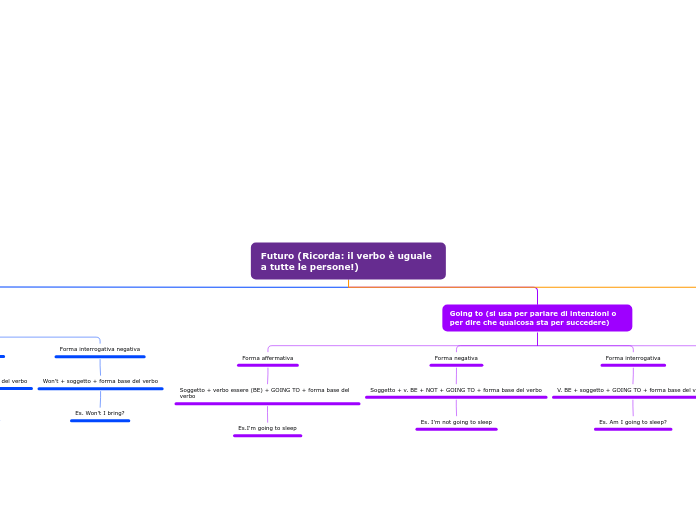Futuro (Ricorda: il verbo è uguale a tutte le persone!)
Present continuous (si usa per parlare di azioni già programmate)
Si forma col SOGGETTO + V. BE + V. Forma base a cui si aggiunge il suffisso - ING (forma affermativa). Per le altre forme valgono le regole dei precedenti verbi ma per ora non sono da studiare; tenete sempre a mente che se incontrate in una frase questa forma si sta parlando di un FUTURO.
Going to (si usa per parlare di intenzioni o per dire che qualcosa sta per succedere)
V. BE + soggetto + NOT + GOING TO + forma base del verbo
Es. Am I not going to sleep?
V. BE + soggetto + GOING TO + forma base del verbo
Es. Am I going to sleep?
Soggetto + v. BE + NOT + GOING TO + forma base del verbo
Es. I'm not going to sleep
Soggetto + verbo essere (BE) + GOING TO + forma base del verbo
Es.I'm going to sleep
Will (si usa per fare previsioni)
Forma interrogativa negativa
Won't + soggetto + forma base del verbo
Es. Won't I bring?
Forma interrogativa
Will + soggetto + forma base del verbo
Es. Will I bring?
Forma negativa
Soggetto + will not (o won't o I'll not) + forma base del verbo
Es. I won't bring (o I will not bring o I'll not bring)
Forma affermativa
Soggetto + will + forma base del verbo
Es. I will bring (o I'll bring)

